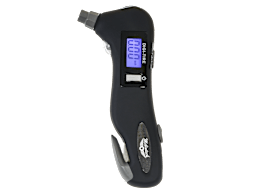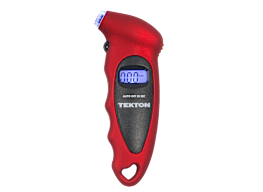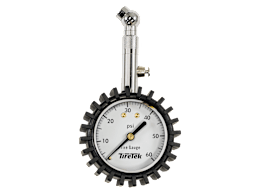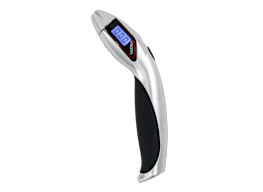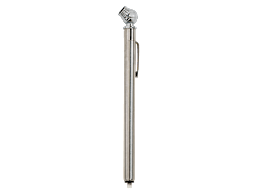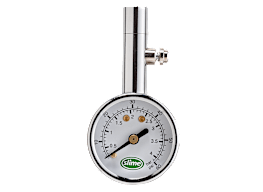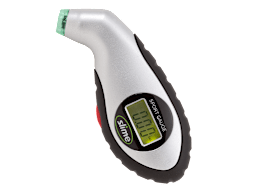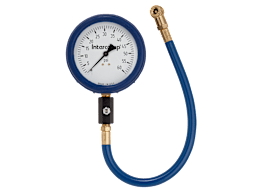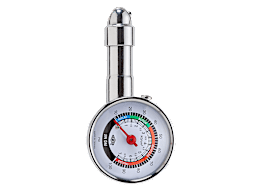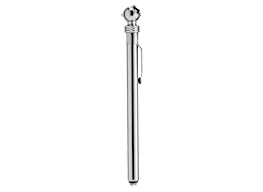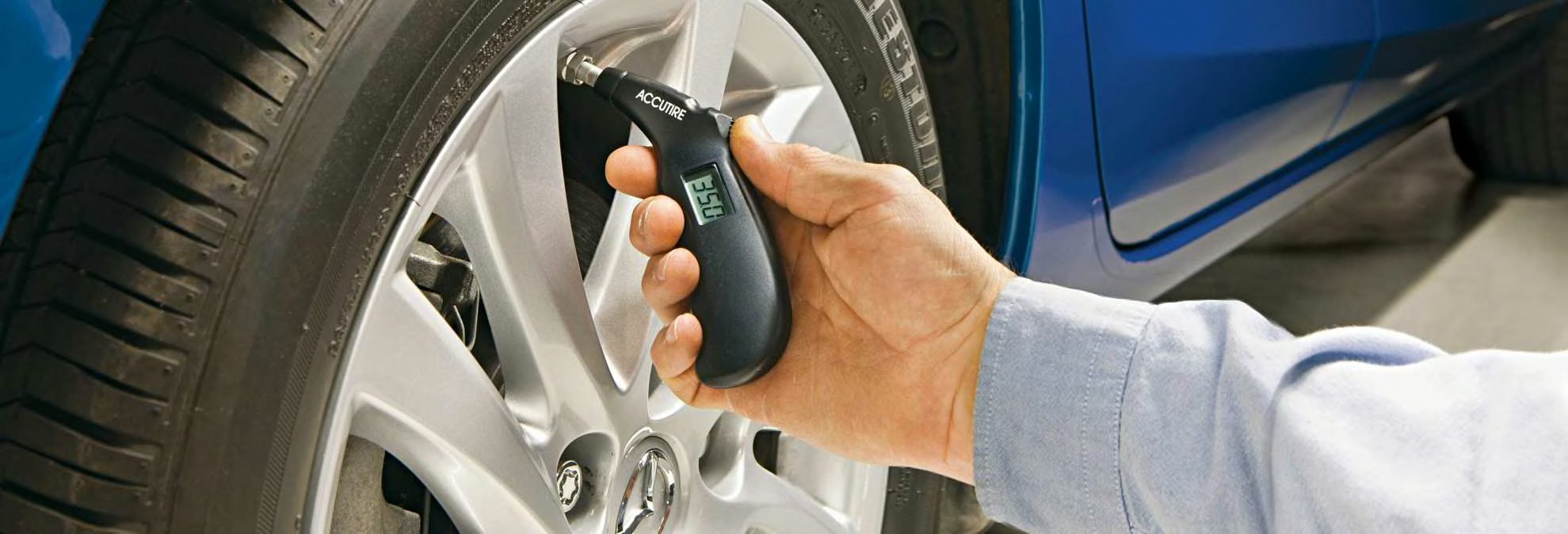
Tire Pressure Gauge Buying Guide
Keeping your car tires properly inflated is an easy maintenance chore that’s vital to your safety. Under-inflated tires build up excess heat as you drive, which can result in tire failure. With too little air pressure, tires can also wear faster and unevenly, waste fuel, and negatively impact the vehicle’s braking and handling. To help maintain tires in top condition, use a tire-pressure gauge to check the pressure of your tires at least once a month and before starting on any long trip. For an accurate read, make sure the car has been parked for three or more hours before checking the tire pressure.
What You Need to Know
Tire-pressure gauges are available at auto-parts stores, big-box stores, and other retailers, as well as online. We have found in our testing that good gauges for consumers typically cost $5 to $15. Keep the tire-pressure gauge in a protective sleeve, as cleanliness will ensure its longevity and accuracy. If a gauge is old, worn, or dirty, or it has been dropped, it may not be reliable and you should get a new one. For the nominal cost, it is a wise investment.
Types
There are three types of tire-pressure gauges: stick, digital, and dial. Buy a gauge with a wide-enough range that it can measure the pressure in a temporary spare, which is typically 60 psi. Many gauges have a span of 5 to 99 psi. If you need to check pressure in a darkened area, consider a digital gauge with an illuminated display. If you buy online to save money, check shipping charges to see if the purchase is still a bargain.
Stick-Type
Stick-type gauges, which somewhat resemble a ballpoint pen, are simple, compact, and affordable, but they are a little harder to interpret than most digital gauges.
Digital
Digital gauges have an electronic LCD display, like a pocket calculator, making them easier to read. They’re also more resistant to damage from dust and dirt. Some digital readouts light up, making them handy for checking pressure in low-light conditions. On the down side, however, digital gauges are a little bulkier than stick gauges and they require batteries. While batteries can last for years, depending on use, they will run down eventually and need replacement.
Dial
Dial gauges have an analog dial, resembling a clock face, with a simple needle to indicate the pressure. Some dial gauges have more features than pocket-sized gauges--including an extension hose, bleeder valve, dual-scale dial, and shock-resistant dial cover--but we have found that they aren’t necessarily more accurate. Most dial gauges are easy to read, but models with an extension hose take two hands to operate. They can also be bulky and typically cost more money, running from $20 to $50.
Latest Test Findings
Our most recent test of tire-pressure gauges looked at 16 models: eight digital, three stick-type, and five dial-type. Those gauges came from seven brands: Accutire, Intercomp, Gorilla, McLintech, Victor, TireTek, and Slime. We tested them for accuracy, ease of use, and durability, and also checked to see how they were affected by ambient temperatures spanning a range from just above freezing to 113-118 degrees F.
Here’s what we found:
• The Accutire MS-4400B topped the Ratings. The heavy-duty dial-type Intercomp 360060 ($55.95) was also very good but is limited to 60 psi.
• The Slime 20048 ($5.99), a dial type, was hard to read, inaccurate when cold, and lost accuracy permanently when dropped onto a concrete floor from a height of 30 inches. The TireTek BooPT18QAC dial gauge had the lowest score due to fair accuracy.
Tire pressure 101
Nearly all tires lose pressure gradually over time, even if the car isn’t driven or the tire isn’t mounted on the car.
With a tire that is undamaged and properly mounted on the rim, most of the pressure loss comes from air migrating through the rubber sidewall, not through the inflation valve.
The valve stem’s dust cap is to keep dirt out, not air in.
Tire pressure drops as the weather gets colder. A typical car tire measured at 30 psi during 80-degree temperatures will register 25 psi when the outside temperature drops to 30 degrees.
While it’s convenient to keep a pressure gauge in the glove box, very hot or cold temperatures can impact performance. It’s better to keep your gauge at room temperature.
The air pressure within a tire is almost unaffected by the weight of the car. An unmounted tire inflated to 32 psi will still measure nearly the same when it’s mounted and bearing the weight of the car.
When checking and adding air to your tires, go by the automaker’s recommended pressure setting, which is usually located on a placard or sticker in the driver’s-side doorjamb or inside the glove compartment or fuel-filler door. This information may also be in your owner’s manual. Don’t go by "max pressure" figure found on the tire sidewall.
How to check and adjust tire pressure
Checking your car’s tire pressure takes only a few minutes. Here’s a step-by-step guide:
1. Use a good, well-maintained tire-pressure gauge. Don’t trust the gauge on a gas station’s air pump to be accurate.
2. Find out what the recommended pressure setting is for your car. This information is usually located on a placard or sticker in the driver’s-side doorjamb, inside the glove compartment or fuel-filler door. Also check your owner’s manual.
Typical inflation pressures range from 28 to 36 psi (pounds per square inch). Many placards also list the metric equivalent in "kPa" (Kilopascal).
Front- and rear-tire pressure may differ.
Important: Use the pressure recommended by your car’s manufacturer, not the "max pressure" figure found on the tire sidewall. The recommended pressure provides the best combination of performance, ride comfort, service life, and fuel economy.
3. Check the pressure when the tires are cold: after they’ve sat for at least three hours and before the car’s been driven more than a couple of miles. Tires heat up as a vehicle is driven, which increases the air pressure and makes it difficult to accurately assess any pressure change.
4. Check each tire by first removing the screw-off cap from each tire’s inflation valve. Be careful not to lose the caps, as they protect the valves.
5. Insert the end of the tire-pressure gauge into the valve and depress it. If you hear air escaping from the valve, push the gauge in further until it stops.
View the pressure reading. Some gauges can be removed to read the pressure value, but others must be held in place on the valve stem. Read the gauge instructions for proper use.
If the pressure is correct, simply retighten the valve cap.
6. Don’t forget to check the pressure of the spare tire. Space-saver "doughnut" spares often have high inflation pressures, usually 60 psi.
How to Add Air to Your Tires
1. If the tire-pressure reading is lower than the recommended psi figure, you’ll need to add air.
If you don’t have a compressor, you can drive to a gas station and use its air-pressure hose. Another option is to buy a portable 12-volt tire inflator, which begin at about $20.
Important: If you have to drive more than a few miles to reach a compressor, the pressure in your tires will rise somewhat. So, remember how much pressure you need to add, take another pressure reading when you get to the gas station, and adjust accordingly. Then check again when the tires have sat for three hours to be sure you have added the correct amount.
2. To add air, first push the hose’s nozzle firmly into the tire’s valve, as you did with the tire gauge. Use your tire-pressure gauge to check the pressure again, and add more air if necessary.
3. If the tire pressure is too high, lower it by pressing a nub on the gauge into the tire valve just far enough to let some air hiss out. Some gauges have a bleed-off valve and most basic gauges have a little prong that can be inserted into the tire valve for this purpose.
4. When finished, be sure to screw the caps back onto the valve stems.
Should you use nitrogen in your tires?
Dealerships and tire shops often charge owners to fill tires with nitrogen, at $5 or more per tire, during routine service visits or when replacing tires. Our testing shows it isn’t worth the paying for.
The claimed benefits are based on the fact that nitrogen molecules don’t leak through a tire’s sidewall rubber as easily as regular air. (Dry air is 78 percent nitrogen, 21 percent oxygen, and 1 percent other gases—and there is almost always some water vapor present.) Therefore, the tires will retain their recommended pressure longer. The reality is that if you check and maintain your tires’ pressure on a regular basis, you’ll get the same benefits that are claimed for nitrogen.
When we tested nitrogen-filled tires versus tires inflated with regular air, we found that all of the tires lost pressure over time. On average, nitrogen did leak more slowly, losing 2.2 psi over the course of a year versus 3.5 psi for air. But either way, you still need to check your tire pressure regularly to maintain it at the recommended level.
Bottom line: Using pure nitrogen in your tires won’t harm your tires, but it provides little benefit on passenger cars.
Learn more about nitrogen in tires.

















